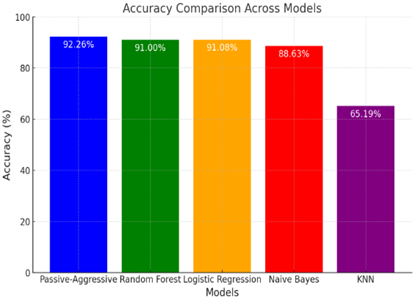Fake News Detection on Social Media Platforms Using Machine Learning and Ensemble Techniques
DOI:
https://doi.org/10.71146/kjmr488Keywords:
Fake news detection, Machine learning, Ensemble methods, Misinformation classificationAbstract
Today, information plays a key role like gold did earlier and news is now mostly read on social media rather than in daily newspapers (18% to 39% share). Due to this change, stories that aren’t real and are meant to shape people’s opinions or harm anyone’s reputation get more attention than genuine news reports on social media. The objective is to help identify reliable news from fake news on social media apps by analyzing and comparing machine learning algorithms.
In this study, many machine learning classifiers like K-Nearest Neighbors (KNN), Logistic Regression and Support Vector Machines (SVM) are tested and made better with valuable data preparation techniques. Ensemble methods are tested against single classifiers to see which gives the most accurate, precise and recall results. Investigating over 6,335 articles, the study used a 30-70 method of dividing into training and testing sets to determine which processing helps most and tests the use of the proposed models in real time.
The results prove that fake news systems work better, assisting media, social networks and the public. The research aids in academia by collecting and comparing different methods for classification and preprocessing, especially to manage problems related to Disinformation, Distortion and Disruption in the digital age.
Downloads

Downloads
Published
Issue
Section
License
Copyright (c) 2025 Hafsa Hussain, Naeem Aslam, Muhammad Fuzail, Tanzeel-Ur-Rehman, Farwa Nazim (Author)

This work is licensed under a Creative Commons Attribution 4.0 International License.






